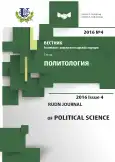Конструирование политического пространства в царских резиденциях ХVII в.: опыт теоретического описания
- Авторы: Топычканов А.В.1
-
Учреждения:
- МГУ имени М.В. Ломоносова
- Выпуск: № 4 (2016)
- Страницы: 136-144
- Раздел: СТАТЬИ
- URL: https://journal-vniispk.ru/2313-1438/article/view/339844
- DOI: https://doi.org/10.22363/2313-1438-2016-4-136-144
- ID: 339844
Цитировать
Полный текст
Аннотация
Переход к Новому времени характеризуется возникновением и развитием культуры резиденций правителей. Благодаря использованию конструктивистского подхода к изучению политического пространства царских загородных резиденций XVII в. удалось установить, что верховная власть была заинтересована в иерархизированном представительстве всех социальных групп, тотализации иерархической структуры, подчеркивающей ее связность, единство и целостность, наделении политической субъектностью исключительно царя. Успех конструирования политического пространства зависел не только от использования нормативных, социальных, пространственных и иных способов организации межличностных отношений, но и от формирования в отсутствие государя политического пространства, имитирующего подлинное политическое пространство и точно определяющего все позиции внутри иерархической структуры, в том числе и самого государя.
Ключевые слова
Об авторах
Андрей Владимирович Топычканов
МГУ имени М.В. Ломоносова
Автор, ответственный за переписку.
Email: topychkanov@gmail.com
Ломоносовский просп., 27, Москва, Россия, ГСП-1, 119991
Дополнительные файлы









